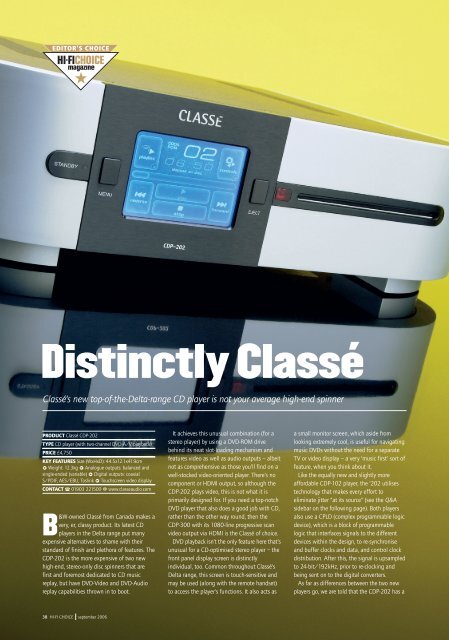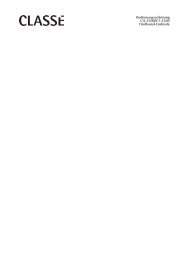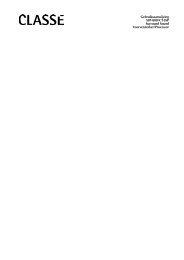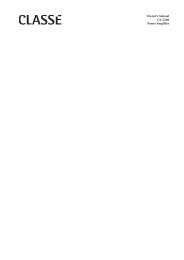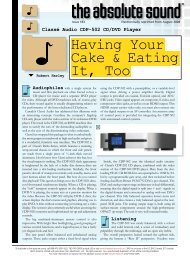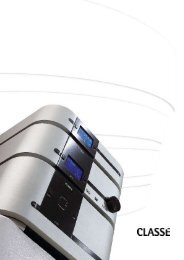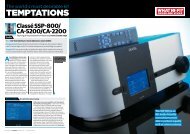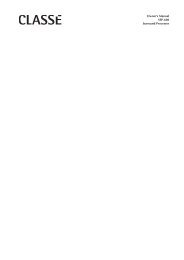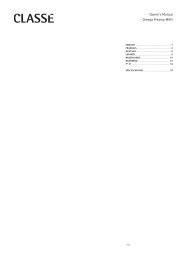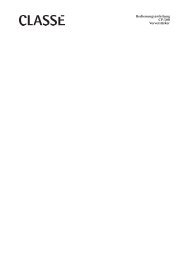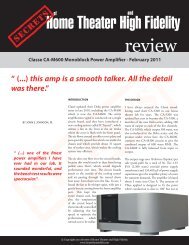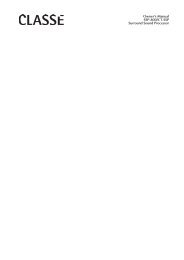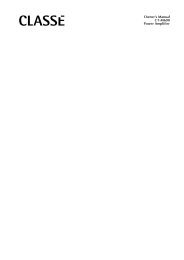CDP-202 Distinctly Classé - Classé Audio
CDP-202 Distinctly Classé - Classé Audio
CDP-202 Distinctly Classé - Classé Audio
Create successful ePaper yourself
Turn your PDF publications into a flip-book with our unique Google optimized e-Paper software.
<strong>Distinctly</strong> Classé<br />
Classé’s new top-of-the-Delta-range CD player is not your average high-end spinner<br />
PRODUCT Classé <strong>CDP</strong>-<strong>202</strong><br />
TYPE CD player (with two-channel DVD-A/V playback)<br />
PRICE £4,750<br />
KEY FEATURES Size (WxHxD): 44.5x12.1x41.9cm<br />
P Weight: 12.3kg P Analogue outputs: balanced and<br />
single-ended (variable) P Digital outputs: coaxial<br />
S/PDIF, AES/EBU, Toslink P Touchscreen video display<br />
CONTACT 01903 221500 q www.classeaudio.com<br />
B&W-owned Classé from Canada makes a<br />
very, er, classy product. Its latest CD<br />
players in the Delta range put many<br />
expensive alternatives to shame with their<br />
standard of finish and plethora of features. The<br />
<strong>CDP</strong>-<strong>202</strong> is the more expensive of two new<br />
high-end, stereo-only disc spinners that are<br />
first and foremost dedicated to CD music<br />
replay, but have DVD-Video and DVD-<strong>Audio</strong><br />
replay capabilities thrown in to boot.<br />
It achieves this unusual combination (for a<br />
stereo player) by using a DVD-ROM drive<br />
behind its neat slot-loading mechanism and<br />
features video as well as audio outputs – albeit<br />
not as comprehensive as those you’ll find on a<br />
well-stocked video-oriented player. There’s no<br />
component or HDMI output, so although the<br />
<strong>CDP</strong>-<strong>202</strong> plays video, this is not what it is<br />
primarily designed for. If you need a top-notch<br />
DVD player that also does a good job with CD,<br />
rather than the other way round, then the<br />
<strong>CDP</strong>-300 with its 1080-line progressive scan<br />
video output via HDMI is the Classé of choice.<br />
DVD playback isn’t the only feature here that’s<br />
unusual for a CD-optimised stereo player – the<br />
front panel display screen is distinctly<br />
individual, too. Common throughout Classé’s<br />
Delta range, this screen is touch-sensitive and<br />
may be used (along with the remote handset)<br />
to access the player’s functions. It also acts as<br />
a small monitor screen, which aside from<br />
looking extremely cool, is useful for navigating<br />
music DVDs without the need for a separate<br />
TV or video display – a very ‘music first’ sort of<br />
feature, when you think about it.<br />
Like the equally new and slightly more<br />
affordable <strong>CDP</strong>-102 player, the ’<strong>202</strong> utilises<br />
technology that makes every effort to<br />
eliminate jitter “at its source” (see the Q&A<br />
sidebar on the following page). Both players<br />
also use a CPLD (complex programmable logic<br />
device), which is a block of programmable<br />
logic that interfaces signals to the different<br />
devices within the design, to re-synchronise<br />
and buffer clocks and data, and control clock<br />
distribution. After this, the signal is upsampled<br />
to 24-bit/192kHz, prior to re-clocking and<br />
being sent on to the digital converters.<br />
As far as differences between the two new<br />
players go, we are told that the <strong>CDP</strong>-<strong>202</strong> has a<br />
38 HI-FI CHOICE september 2006
Classé <strong>CDP</strong>-<strong>202</strong> CD player [ Review ]<br />
“DVD playback isn’t the only feature that’s<br />
unusual for a CD-optimised stereo player –<br />
there’s the front panel display screen, too.”<br />
“greater number and cost of parts” compared<br />
to the <strong>CDP</strong>-102. This means double the<br />
number of Burr-Brown PCM1792 converters,<br />
each channel operating in double balanced<br />
mode, with each half of each channel’s signal<br />
being converted differentially. This eliminates<br />
noise, but requires great precision of<br />
manufacture to ensure things don’t get out of<br />
sync in the process. It’s not hard to see why<br />
Classé is keen that this player should be<br />
listened to via its balanced outputs. That said,<br />
the single-ended circuits have their own DACs<br />
and filtering, too. This means they remain<br />
completely independent, which is useful if your<br />
amp doesn’t have balanced inputs.<br />
On the connections front, you’ll<br />
find analogue outputs in balanced<br />
and single-ended form, digital in<br />
all three flavours and video in<br />
coaxial and S-Video varieties.<br />
Thanks to an on-board volume<br />
control, the players’ analogue<br />
output can be used directly into a<br />
power amp and there are various<br />
parameters that can be set for this<br />
feature, via the touchscreen menu system.<br />
This control system is pretty wild. It contains<br />
a number of menus that allow the user to<br />
adjust a broad array of parameters. These<br />
include variations on digital output, lip sync for<br />
video, format preference, ‘teach IR’ (which<br />
sends a signal from the player to a third party<br />
remote) and programming for the four ‘F’ keys<br />
on the supplied remote, the latter making it<br />
easier to access the more obscure features of<br />
the player. There is even a data display that<br />
tells you the internal temperature of the player<br />
and the voltage coming in from the mains,<br />
plus much more.<br />
In fact, some of these readings are so obscure<br />
that it’s difficult to see a rationale behind<br />
them. For example, a display for the front<br />
channel level (as you would find in a<br />
multichannel processor) is seemingly pointless<br />
in the context of a two-channel device. In<br />
fairness, though, there is a digital output for<br />
Dolby and DTS streams, so surround can be<br />
achieved if you have a processor.<br />
We asked Classé why it had chosen a slot<br />
rather than drawer loading drive and the main<br />
reason given is that it was chosen to<br />
“complement the industrial design of the<br />
Classé Delta series”. Classé claims that there<br />
are no sonic pros or cons to this approach, but<br />
consider reliability to be higher than the<br />
drawer approach. One practical drawback with<br />
the slot drive is that once a disc is ejected the<br />
player is unable to suck it back in – you have to<br />
push it in manually, but we’d guess that P<br />
september 2006 HI-FI CHOICE 39
Q&A<br />
We spoke to Alan Clark, Classé’s<br />
chief development officer, about<br />
the design of the <strong>CDP</strong>-<strong>202</strong><br />
HFC Your literature refers to<br />
“killing jitter at its source”.<br />
How do you achieve this?<br />
AC Jitter is always present in a digital signal<br />
propagation path. For example, in a mixed signal<br />
design (digital and analogue electronics) the<br />
instant of data conversion into the analogue<br />
domain is a key point in determining the quality<br />
of the converted audio. If jitter has been allowed<br />
to accumulate in the digital domain to this<br />
point, conversion will be compromised, resulting<br />
in an audible reduction of fidelity. Killing jitter at<br />
its source is a simple way of saying that at each<br />
stage of the circuit, measures are taken to ensure<br />
that jitter is controlled.<br />
Given its potential as a preamp, why doesn’t<br />
the <strong>CDP</strong>-<strong>202</strong> include a digital input?<br />
We find so few two-channel digital sources being<br />
used that we didn’t feel it would have justified<br />
the development effort to do it properly. Most<br />
people today use surround processors in the role<br />
formerly filled by outboard digital converters. A<br />
digital input that cannot also handle<br />
multichannel signals (even if they are to be<br />
downmixed for two-channel playback) is of<br />
limited value. In this context, you can see that<br />
we would have felt the need to do more than<br />
simply add an S/PDIF digital receiver and<br />
connector to the chassis.<br />
Why doesn’t it have a high-quality video<br />
output such as component or HDMI/DVI?<br />
We now have four players in the Delta range:<br />
two focus on two-channel audio (<strong>CDP</strong>-<strong>202</strong> and<br />
<strong>CDP</strong>-102), the other two (<strong>CDP</strong>-300 and CDT-300)<br />
are more home cinema focussed. Our <strong>CDP</strong>-300<br />
and CDT-300 support component video output<br />
and HDMI up to and including 1080p. In other<br />
words, if you want component and HDMI, you<br />
will also want deinterlacing and scaling. With<br />
the <strong>CDP</strong>-102 and <strong>202</strong>, the money is spent on<br />
audio. For about $10 in parts, it was a simple<br />
matter to offer S-Video and composite outputs,<br />
as the unit is capable of decoding video. This<br />
feature can be handy for DVD-<strong>Audio</strong>, if the unit’s<br />
front panel isn’t close by. It also lets the user<br />
watch an occasional DVD movie if there is a TV<br />
as part of the audio system.<br />
Q non-reviewers won’t be too concerned about<br />
this. The remote handset is a chunky tube of<br />
aluminium with keys that illuminate every time<br />
you use one, and the usual array of functions<br />
you’d find on a DVD remote – plus volume,<br />
mute and the aforementioned F keys.<br />
SOUND QUALITY<br />
It took a while, a week or so, for this player to<br />
come on song and deliver a sound that was<br />
commensurate with its price tag. But, once it<br />
got there, we had a grand time revelling in<br />
fine detail and textures that are rarely<br />
encountered with CD.<br />
Initial impressions are of a smooth and<br />
luxurious sound that reflects the build quality,<br />
but doesn’t suggest tremendous transparency.<br />
Indeed, early comparisons with our Townshend<br />
TA 565 CD reference player made the<br />
newcomer seem rather lacking in definition.<br />
Some of this, it turned out, was due to<br />
limitations in the transparency of the<br />
amplification and not a function of the player<br />
itself. Once that had been sorted, the Classé<br />
began to come into its own, revealing a degree<br />
of finesse and smoothness that delivers music<br />
in a relaxed and natural fashion, without<br />
seeming to add any emphasis of its own.<br />
40 HI-FI CHOICE september 2006
Classé <strong>CDP</strong>-<strong>202</strong> CD player [ Review ]<br />
Detail<br />
Analogue<br />
audio circuits<br />
(single-ended<br />
circuitry is<br />
central,<br />
balanced<br />
circuitry left<br />
and right)<br />
Burr-Brown<br />
PCM1792<br />
D-to-A<br />
converters<br />
(two for<br />
balanced<br />
audio, one for<br />
single-ended<br />
operation)<br />
24-bit/192kHz<br />
upsampler<br />
Mains<br />
transformer<br />
for audio<br />
board<br />
Touchscreen display panel<br />
Slot-loading<br />
TEAC DVD-ROM<br />
transport<br />
mechanism<br />
Power supply<br />
for transport<br />
mechanism,<br />
control<br />
system and<br />
display<br />
The player is unusual in that it doesn’t have<br />
any tendency to try and etch out the image or<br />
time signature of the music, but rather fills in<br />
more of the ‘steps’ in the signal and provides a<br />
more complete and refined soundscape. There<br />
are those who will prefer a more emphatic and<br />
distinctly defined soundstage, but in a<br />
high-resolution system, the extra detail<br />
provided by the Classé makes a strong case for<br />
its more subtle approach. To draw an artistic<br />
analogy, a line drawing produces a more<br />
strongly defined image than a painting of the<br />
same subject, because the latter doesn’t have a<br />
distinct line between objects, but a change in<br />
colour and shade. This is what the Classé<br />
makes other players sound like; as if they are<br />
telling you where the line is, but failing to fill<br />
in the fine detail of the shading.<br />
The <strong>CDP</strong>-<strong>202</strong> does a remarkable job of<br />
tracking level. It clearly brings out differences<br />
between tracks that other players make less of.<br />
This is probably due to the noise reducing<br />
abilities of the balanced output that was used<br />
for most of our listening. It can also be played<br />
louder than average without discomfort, which<br />
is a sure sign of very low distortion. We found<br />
ourselves winding up the wick on Fink’s<br />
‘alt.folk’ tunes rather further than is the norm,<br />
which is a lot of fun. It also works at the other<br />
end of the scale too, tracking the level of<br />
different notes and voices within the music to<br />
provide a more complete picture of the ebb<br />
and flow of the entire piece.<br />
Moving over to DVD-<strong>Audio</strong> replay did<br />
nothing to undermine the confidence this<br />
player inspires, an orchestral piece (Beethoven<br />
Symphony No.6, Barenboim, Berlin<br />
Staatskapelle) providing the impetus for the<br />
player to revel in the depth and space of the<br />
“In a high-resolution system, the extra detail<br />
provided by the Classé <strong>CDP</strong>-<strong>202</strong> makes a<br />
strong case for its more subtle approach.”<br />
recording. This made it easy to hear where<br />
each section of the orchestra was sitting in<br />
both lateral and stage depth terms. This format<br />
really brings out the best in the Classé,<br />
widening the divide between it and our<br />
reference considerably. Its degree of refinement<br />
goes significantly beyond the resolve that’s<br />
available from a CD, something that is<br />
probably the case with other high-end players,<br />
but which is emphasised here by the relative<br />
quality of a higher resolution format. It clearly<br />
extends further than usual at high frequencies<br />
and has a naturalness through the midband<br />
that is totally ‘un-digital’ in its finesse and lack<br />
of even a hint of grain.<br />
So, is the <strong>CDP</strong>-<strong>202</strong> really a world beater?<br />
Well, it’s certainly an exceptional beast in<br />
many respects and among the very best audio<br />
players we’ve heard in the £5,000 ballpark.<br />
There’s plenty of high-quality competition at<br />
this level, of course, and in the end it is largely<br />
a matter of sonic preference. Those who like a<br />
more direct, clear-cut sort of sound may lean<br />
more towards the likes of Naim, for example.<br />
But if smooth refinement, power and poise<br />
sounds like your bag, the chances are you’ll be<br />
hugely impressed by this Classé.<br />
The last thing we’d want to suggest is that<br />
the <strong>CDP</strong>-<strong>202</strong> glosses over fine detail in the<br />
quest for a smooth result. There are plenty of<br />
players that do just that, but not the Classé.<br />
Present it with a hard-sounding disc and it<br />
sounds just that – hard. But give it a good<br />
quality recording and it will astonish you with<br />
its natural sense of musical texture, light and<br />
shade. It delivers CDs with the skill of an<br />
accomplished artist, and offers the bonus of<br />
excellent two-channel DVD-<strong>Audio</strong>/Video<br />
replay, too. For the depth of its sonic resolve,<br />
this player is almost in a Classé of its own. HFC<br />
Jason Kennedy<br />
VERDICT<br />
SOUND >> 94%<br />
FEATURES >> 92%<br />
BUILD >> 94%<br />
VALUE >> 85%<br />
R PRO<br />
High-resolution CD player<br />
with exceptional smooth and<br />
refined sound, plus the added<br />
bonus of DVD-<strong>Audio</strong>/Video<br />
replay. Great roster of features<br />
via touchscreen control.<br />
S CON<br />
Some may find the sound a<br />
little too relaxed. Facilities on<br />
the video side are limited –<br />
but this player is all about<br />
two-channel audio.<br />
CONCLUSION<br />
The <strong>CDP</strong>-<strong>202</strong> is principally a high-end CD player, with DVD-<strong>Audio</strong><br />
and Video playback included as a bonus. It’s beautifully built<br />
and bristling with unusual features, plus a sound that is refined<br />
and resolute. If sophistication is your bag, it’s hard to beat.<br />
OVERALL SCORE 90% >><br />
september 2006 HI-FI CHOICE 41


